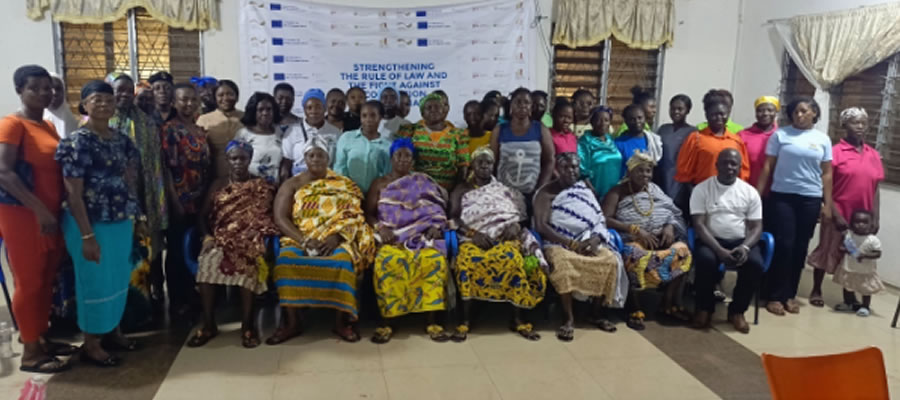

Population size and age-sex structure is one of the fundamental ways to understand social and economic implication of fertility, mortality and migration dynamics. The changes over time in age and sex composition gives insights into changing phenomenon and highlights in future socioeconomic challenges.
In terms of size and distribution, according to the 2021 PHC revealed that, the municipality has a population of 144947 comprising 50.4% males and 49.6% female. This high male population may be due to the fact that, the municipality is a farming community and a lot of males migrate to the municipality for farming activities. The land size is 2571km2 with a population density of 56.4 persons/km2. The average household size is 4.5
With respect to locality of residence, the 2021 PHC revealed that 56.95 percent of the population lives in the urban areas while 43.05 percent lives in the rural communities. The age-sex structure of the municipality is in the form of a pyramid with a broad base and narrow apex.
Age - Sex Structure
The Municipal has a relatively large male population compared to that of female which makes it unique to compare both Regional and the national statistics. The large male population in the Municipal is due partly to the continuous influx of settler farmers who come into the Municipal to tap the district’s agricultural potentials. It has been observed that most of these settler farmers if not all are males.
In terms of age structure, the Municipal has a large youthful population. The two cohort that contains most of the people are the 0-14 group and 15 –64 group (See Table 4).
Another significant feature of the Municipal population is its large labor force. The cohort that falls within the active labor force constitutes 52.9% of the Municipal population. This is a bit higher than the regional and national active labor force of 52.4%. This large active labor force could be positioned to harness and maximize the vast agricultural potentials of the district. Though the dependent population of 47.1% can also be said to be high, the number of dependants could be lower since most of those in the aged senile age group could still be engaged in one or other form of agricultural production.
Population Density
The population density of the Municipal has never been stable nor has it experienced any decline over time. The increase in population over time is reflected in the high population densities recorded for the period 1970, 1984 and 2000 (See Table 1.5). The number of persons per square kilometer (density) as at each of the population censuses has increased from 9 persons in 1970 to 14 persons in 1984 to 24 persons in 2000 and to 40 persons in 2010. The increasing density in time shows the increasing pressure of the district’s population on the land and its resources. This may be an indication of growing pressure on the district’s fragile environment which may gradually result in environmental degradation.
There is high concentration of people in the two major towns of the Municipal - Atebubu and Amantin. There are also pockets of concentration in the settlements along the main Kumasi-Ejura-Atebubu trunk road. This trend could be attributed to the availability of economic opportunities and social services in the two major towns of the Municipal and the opening up of the area by the Kumasi-Ejura-Atebubu highway.
Rural/Urban Split
The population of the Municipal is basically rural. About 53% of the people reside in the rural areas. The remaining 47% of the people can be found in the only two main towns of the district, Atebubu and Amantin. Apart from these two towns, the other settlements have their population figures below 5000. Refer to Figure 3 for the spatial distribution of settlements of various population sizes in the district.
Settlement Systems
This section discusses the spatial organization of settlements in the district. It provides a summary of the socio-economic profile within a spatial context. It further deals with the type, number, distribution of facilities and services, and how these factors ultimately shape the hierarchy of settlements in the district.
Settlements Pattern
The spatial pattern of settlements in the Municipal could generally be described as dispersed, with the exception of a few settlements located along the major Atebubu-Yeji road. There are only two urban settlements in the district, namely, Atebubu and Amantin, through which one of the subsidiary highways linking Northern Ghana with Southern Ghana passes. At the moment, this highway is the only paved road within the district. This settlement pattern, coupled with the generally low population thresholds of these settlements has made it very expensive and difficult to economically distribute projects including road networks in the district.
Geographical Distribution of Services
An analysis of the distribution of services using the Scalogram Analysis technique shows that facilities and services are not evenly distributed within the district. The Scalogram is a non-statistical tool that arrays facilities and services by their ubiquity and ranks settlements by their functional complexity, on a matrix. By this, the settlements were ranked based on both their population, the number of facilities and type of services they offer. The distribution of these services and facilities in the selected settlements are presented in the Scalogram (See Table 1.19) for details.
In constructing the scalogram, the top 25 settlements in terms of population size, with populations ranging from 460 to over 23,000 people were selected and arranged in a descending order. Also, a total of 26 functions cutting across commerce, security, transport and communication, public administration, education, health and sanitation, water supply, recreation and other areas were considered. The functions were weighed according to their level of complexity. Subsequently, the Total Centrality for each settlement was determined.
From the analysis, Atebubu and Amantin were found to be performing more functions than the other settlements in the district. Next to these settlements in the functional order were New Konkrompe and Kumfia. This is a clear indication of spatial inequity, and if not corrected, will polarize the Municipal population and resources at the urban areas leaving the rural communities more deprived. Conscious efforts are needed to re-direct population concentration in Atebubu and Amantin to the other major settlements in the Municipal through well balanced and equitable distribution of facilities and services.
Hierarchy and Distribution of Settlements
Weights were assigned to various services and facilities and the total centrality index which represents the degree to which each of the settlements provide functions to people in other areas, was then calculated, and this was used to classify settlements into five levels of hierarchy. The hierarchy of settlements based on the functions of the settlement was found to run at par with the population sizes of the communities. This is shown in Table 1.20.
The scalogram depicts spatial inequalities in the distribution of services and facilities. Atebubu alone has 22 facilities and services, Amantin has 12 facilities and services and Jato-Zongo has 11 facilities and services, leaving the remaining settlements with less than 11 facilities and services. It has also been observed that population and services in the Municipal are concentrated along the major (road) highway. Such a skewed distribution reinforces the primacy of Atebubu. A deliberate development policy is required to resource deficient areas, for example by upgrading some settlements, through the provision of relevant services at the appropriate scale.
Date Created : 3/27/2023 6:48:27 AM












 facebook
facebook
 twitter
twitter
 Youtube
Youtube
 +233 593 831 280
+233 593 831 280 0800 430 430
0800 430 430 GPS: GE-231-4383
GPS: GE-231-4383 info@ghanadistricts.com
info@ghanadistricts.com Box GP1044, Accra, Ghana
Box GP1044, Accra, Ghana